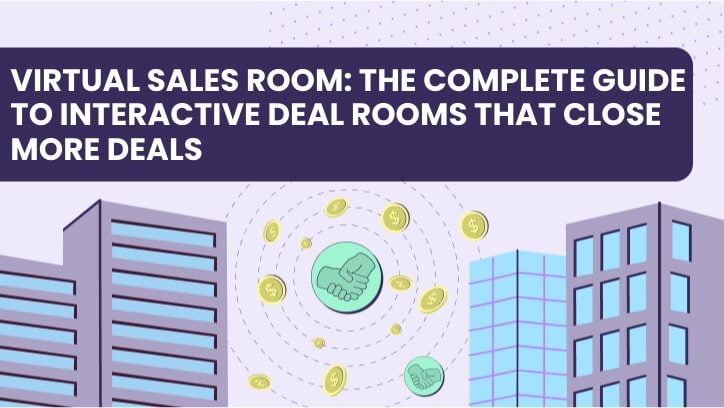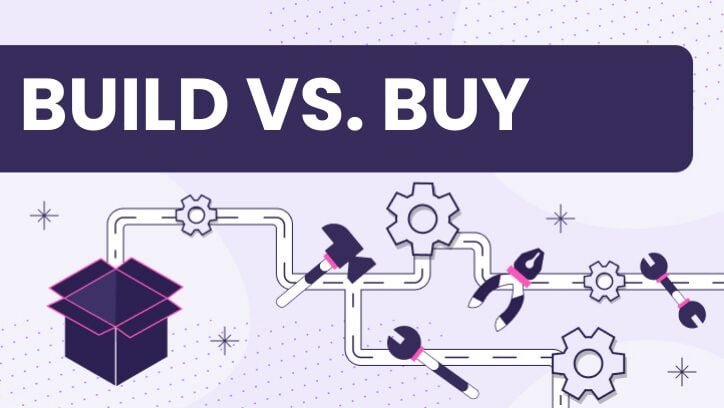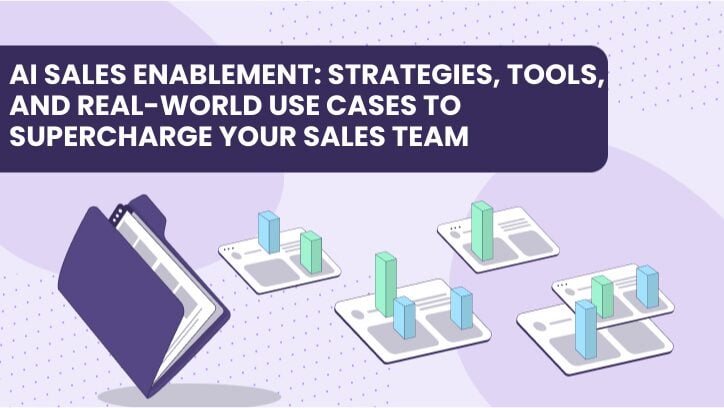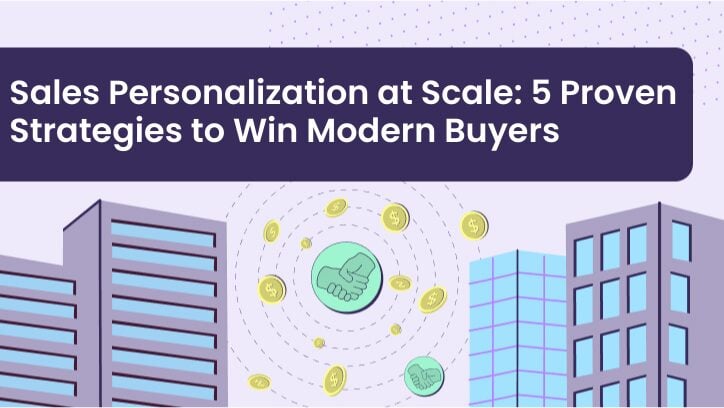Today’s competitive B2B market requires sales teams to bring more than traditional presentations and email threads to the table if they want to engage prospects effectively. Enter the virtual sales room, a new way sellers interact with potential buyers. Many may know them as Digital Sales Rooms (DSR).
At Walnut, we’ve revolutionized this concept by creating Interactive Deal Rooms (IDR) that seamlessly integrate our native interactive demos with comprehensive digital sales room functionality. We’re talking next-gen buyer enablement.
What is a Virtual Sales Room?
A virtual sales room is a digital sales room designed to centralize all sales-related content, communications, and interactions in one easy to access platform. Think of it as a personalized microsite where prospects can explore your offerings, access relevant resources, and engage with your sales team in real-time.
In Walnut’s world, we call this an Interactive Deal Room because it goes beyond static content repositories. Our platform embeds interactive product demos natively within the digital sales room, creating an immersive experience that traditional digital sales room solutions simply can’t match.
The Evolution of Digital Sales Room Technology
DSRs have evolved a great deal since Gartner’s 2020 study popularized the term “client portals.” What started as simple content repositories has morphed into sophisticated deal room platforms that serve as flexible, accessible, and personalized microsites for clients.
This evolution reflects broader changes in B2B buyer behavior. According to McKinsey research, B2B customers now use more than nine channels during their buying journeys, and over 65 percent of companies prefer remote and digital interactions. More critically, over 70 percent of businesses will consider alternative vendors if their core requirements aren’t met during the buying experience.
Modern virtual sales rooms function as comprehensive content management systems that consolidate sales assets into centralized repositories. Sales representatives can set up these deal rooms using various sales enablement tools, creating personalized experiences accessed through custom URLs or secure access forms.
Core Components of an Effective Virtual Sales Room
Content Repositories and Story Management
At the heart of every successful digital sales room lies a robust content management system. These repositories contain collections of content organized as “stories”—essentially deal room templates that serve as frameworks for sharing documents related to specific deals.
Sales managers can create standardized stories within content repositories to streamline the distribution of essential documents to prospects. This systematic approach ensures consistency across the sales pipeline while reducing preparation time for individual deals.
Sales representatives maintain the flexibility to curate their own content stories or modify existing deal room templates by adding or removing specific files. This balance between standardization and customization enables teams to maintain brand consistency while addressing unique prospect needs.
Flexible Content Sharing Options
Modern digital sales rooms offer multiple sharing mechanisms to accommodate different buyer preferences and sales scenarios. Sales reps can distribute content via email, direct links, or through dedicated interactive deal rooms.
The virtual sales room provides options for both quick content sharing and creating fully branded environments for ongoing prospect engagement. This flexibility ensures that whether you’re handling a quick information request or managing a complex enterprise deal cycle, your digital sales room adapts to the situation.
Key Benefits of Implementing Virtual Sales Rooms
Real-Time Collaboration for Accelerated Deal Progression
One of the most significant advantages of a digital sales room is its ability to replace lengthy email threads with consolidated, interactive platforms. Instead of prospects digging through forwarded emails to find relevant information, they can log into their virtual sales room and find all necessary sales materials organized for their convenience.
This centralized approach transforms information sharing from a cumbersome process into a streamlined experience. When prospects need to share information with colleagues or decision-makers, they can do so directly from the deal room without forwarding multiple emails or attachments.
The self-service nature of virtual sales rooms enhances the buyer’s purchasing and learning experience. Prospects can access information on their schedule, dive deeper into areas of interest, and share resources with their team members seamlessly.
Enhanced Buyer Engagement Through Personalization
Digital sales rooms provide centralized platforms where buyers can access curated assets tailored to their specific interests and pain points. This personalization transforms generic sales interactions into targeted experiences that resonate with individual prospects.
Research from McKinsey reveals that while only 8 percent of B2B organizations currently deliver highly personalized marketing, three-quarters of that group report growing market share. This stark contrast highlights the competitive advantage available to organizations that embrace personalized virtual sales room strategies.
The ability for buyers to easily share information with others directly from the virtual sales room increases internal collaboration and enhances overall engagement. When prospects can effortlessly involve their colleagues in the evaluation process, it often accelerates decision-making.
Personalization through interactive deal rooms transforms the sales process into a self-serve purchasing and learning experience, significantly boosting buyer satisfaction. This approach is particularly valuable during long and complex deal cycles where maintaining engagement becomes challenging.
Data-Driven Insights for Smarter Selling
Modern virtual sales rooms track every interaction with hosted assets, providing sales representatives with valuable insights into prospect behavior. These analytics reveal which content resonates most with buyers and how much time they spend engaging with different materials.
Companies with strong customer analytics capabilities are 1.5 times more likely to experience rapid growth and can drive earnings increases of 15-25 percent, according to McKinsey research. This demonstrates the significant competitive advantage available through data-driven digital sales room strategies.
The invite function within digital sales rooms allows buyers to add team members to the room, helping sellers identify and track new stakeholders in the buying process. This visibility into the expanding buyer committee enables more strategic sales approaches.
Analytics help sales reps optimize their content management by indicating what materials to add or remove from the deal room. This data-driven approach ensures that virtual sales rooms remain relevant and valuable throughout the entire sales cycle.
Setting Up Your Virtual Sales Room for Success
Creating Effective Deal Room Templates
Successful digital sales room implementation begins with developing comprehensive deal room templates that serve various sales scenarios. These templates should include essential materials while providing flexibility for customization based on specific prospect needs.
Your content management system should organize materials logically, making it easy for prospects to navigate and find relevant information. Consider creating different deal room templates for various buyer personas, company sizes, or use cases.
Implementing Mutual Action Plans
Mutual action plans represent one of the most powerful features of modern virtual sales rooms. These collaborative documents outline the steps both buyer and seller need to complete to move the deal forward successfully.
Within your interactive deal room, mutual action plans become living documents that both parties can reference and update. This transparency helps maintain momentum throughout the deal cycle while ensuring all stakeholders remain aligned on next steps.
Optimizing the Sales Pipeline Integration
Your virtual sales room should integrate seamlessly with your existing sales pipeline management tools. This integration ensures that prospect interactions within the digital sales room are captured and reflected in your CRM system.
Proper integration enables sales representatives to track deal progression more effectively while providing managers with visibility into buyer engagement across the entire sales pipeline.
Advanced Features That Differentiate Interactive Deal Rooms
Native Demo Integration
What sets Walnut’s interactive deal rooms apart is the native integration of interactive product demonstrations. Instead of static screenshots or separate demo environments, prospects can engage with fully interactive product experiences directly within their virtual sales room.
This seamless integration eliminates friction in the buyer journey while providing more comprehensive insights into prospect interests and behavior.
Shareable Link Functionality
Modern digital sales rooms provide sophisticated shareable link capabilities that maintain security while enabling easy access. These links can be customized with expiration dates, password protection, and view limitations to ensure appropriate access control.
The shareable link feature makes it simple for prospects to involve additional stakeholders without compromising security or creating administrative overhead for sales teams.
Comprehensive Viewer Insights
Advanced virtual sales rooms provide detailed insights on who has viewed the deal room, when they accessed it, and which content captured their attention. These insights enable sales representatives to tailor their follow-up communications and identify the most engaged prospects within the buying committee.
Understanding viewing patterns helps sales teams prioritize their efforts and customize their approach based on demonstrated interest levels.
Best Practices for Virtual Sales Room Success
From Sales Funnel to Customer Buying Journey
The most successful digital sales room implementations reflect a fundamental shift in thinking—from traditional “sales funnel” mentality to a “customer buying journey” mindset. This transition recognizes that modern B2B buyers spend approximately one-third of their time engaging with self-serve content across all stages of their evaluation process.
Smart companies are moving away from artificial metrics like marketing-qualified leads (MQLs) toward “conversation readiness” approaches that respect buyers’ timelines and preferences. This shift enables marketing to play a deeper role in the customer lifecycle rather than simply pushing leads that may have little purchasing intent.
Content Curation and Management
Effective digital sales room management requires ongoing attention to content relevance and organization. Given that most sales organizations spend $500 to $1,000 per representative on sales technology, yet barely more than half achieve good adoption rates, the focus must be on quality over quantity.
Regularly audit your deal room materials to ensure they remain current and valuable to prospects. Implement a systematic approach to content updates, removing outdated materials while adding fresh, relevant resources that address evolving buyer needs and market conditions.
Buyer Engagement Strategies
Maximize buyer engagement by creating interactive elements within your virtual sales room beyond traditional content consumption. Consider incorporating polls, feedback forms, or interactive calculators that encourage active participation.
Use the insights gathered from deal room interactions to personalize future communications and tailor your sales approach to demonstrated interests and concerns.
Sales Enablement Integration
Your virtual sales room strategy should align closely with broader sales enablement initiatives. Ensure that your interactive deal rooms support your overall sales methodology while providing the tools and resources sales representatives need to succeed.
Regular training on digital sales room best practices helps ensure consistent implementation across your sales organization while maximizing the platform’s impact on deal progression.
Measuring Virtual Sales Room ROI
Key Performance Indicators
Track meaningful metrics that demonstrate the impact of your digital sales room implementation. Focus on deal cycle reduction, buyer engagement rates, and conversion improvements rather than vanity metrics.
Monitor how virtual sales rooms affect your overall sales pipeline velocity and identify opportunities for optimization based on performance data.
Continuous Optimization
Use the data gathered from your interactive deal rooms to continuously refine your approach. Test different content arrangements, engagement strategies, and feature utilization to maximize effectiveness.
Regular analysis of deal room performance helps identify successful patterns that can be replicated across your sales organization.
The Future of Virtual Sales Rooms
As buyer expectations continue to evolve, virtual sales rooms will become increasingly sophisticated in their ability to provide personalized, interactive experiences. The integration of artificial intelligence and advanced analytics will further enhance the insights available to sales teams.
Interactive deal rooms represent the future of B2B sales engagement, providing the foundation for more effective, efficient, and buyer-centric sales processes. Organizations that embrace this technology today will be better positioned to succeed in tomorrow’s competitive landscape.
Transform Your Sales Process with Virtual Sales Rooms
Virtual sales rooms have transformed from simple content repositories into sophisticated interactive deal rooms that drive real business results. By centralizing sales materials, enabling real-time collaboration, and providing valuable buyer insights, digital sales rooms empower sales teams to engage more effectively with prospects throughout the entire deal cycle.
For organizations ready to modernize their sales approach, implementing a comprehensive virtual sales room strategy represents one of the most impactful investments they can make in their sales enablement infrastructure. The combination of improved buyer experience, enhanced seller productivity, and data-driven insights creates a compelling case for digital sales room adoption.
Success with virtual sales rooms requires thoughtful planning, consistent execution, and ongoing optimization. But for organizations committed to providing exceptional buyer experiences while accelerating their sales pipeline, interactive deal rooms offer a clear path to improved sales performance and sustained competitive advantage.
Ready to close deals faster and give buyers the experience they expect? See how Walnut’s virtual sales rooms—powered by native interactive demos—help you centralize content, personalize every interaction, and track engagement in real time. Get started today.





